Easter Side Dishes
Easter is right around the corner and that means another celebratory meal. In this recipe round up, we focus on Easter Side Dishes. For any Easter affair, it makes sense to keep Spring in mind when we choose our side dishes. Many of our favorite vegetables will be back fresh on the shelf, like peas, asparagus and artichokes. We don’t want to miss out on their sweet, Spring deliciousness so we include a few recipes where they are highlighted.
Of course, our Easter Side Dishes should also be full of great taste and variety. Included also in our Easter Side Dish list are tasty beet tarts with goat cheese and a tomato tart made with puff pastry. Also included is one of our favorites – Pomme Anna! Yum! And although we often think of risotto as a main dish, below is a recipe for a delicious spring risotto recipe that makes for a great Easter Side Dish.
I hope you enjoy and Happy Easter.
Easter Side Dishes – Potatoes Anna

- 3-4 medium baking potatoes
- 4 tbsp of butter
- a small bunch of fresh thyme
- salt and pepper
- Preheat the oven to 400F.
- Line a baking tray with a piece of parchment paper.
- Wash and peel the potatoes.
- Melt the butter.
- Using a knife, v-slicer or mandolin, thinly slice the potatoes (try for an 1/8th of an inch) end to end slicing as evenly as possible.
- On the parchment paper, fan out one layer of potatoes in a circle about 5 inches in diameter.
- Using a pastry brush, coat the potato fan with butter.
- Season the potato fan with salt and pepper.
- Sprinkle the potato fan with sprigs of fresh thyme.
- Add a second layer of fanned potatoes. Brush with butter, season with salt and pepper and season with fresh thyme.
- Repeat the above steps until 4 individual potato rounds are made.
- Cover the baking pan with aluminium foil. Bake the potatoes for 25-30 minutes until they are tender.
- Remove the foil and bake another 25-30 minutes until the potatoes are golden and the edges are crisp.
- Serve hot.
- You can add as many layers as you would like. The thicker the potatoes, the longer the first baking time will be.
- The potato layers can be baked, cooled and reheated the day of the meal. For this dish, freshly made is best though.
- Other herbs like rosemary can certainly be used as can finely chopped garlic. Very thin slices of sweet onion can also be put into the layers.
- For a vegan option, omit the butter and replace it with vegan, soy margarine.
Easter Side Dishes – Buttery Peas and Asparagus in Artichoke Cups
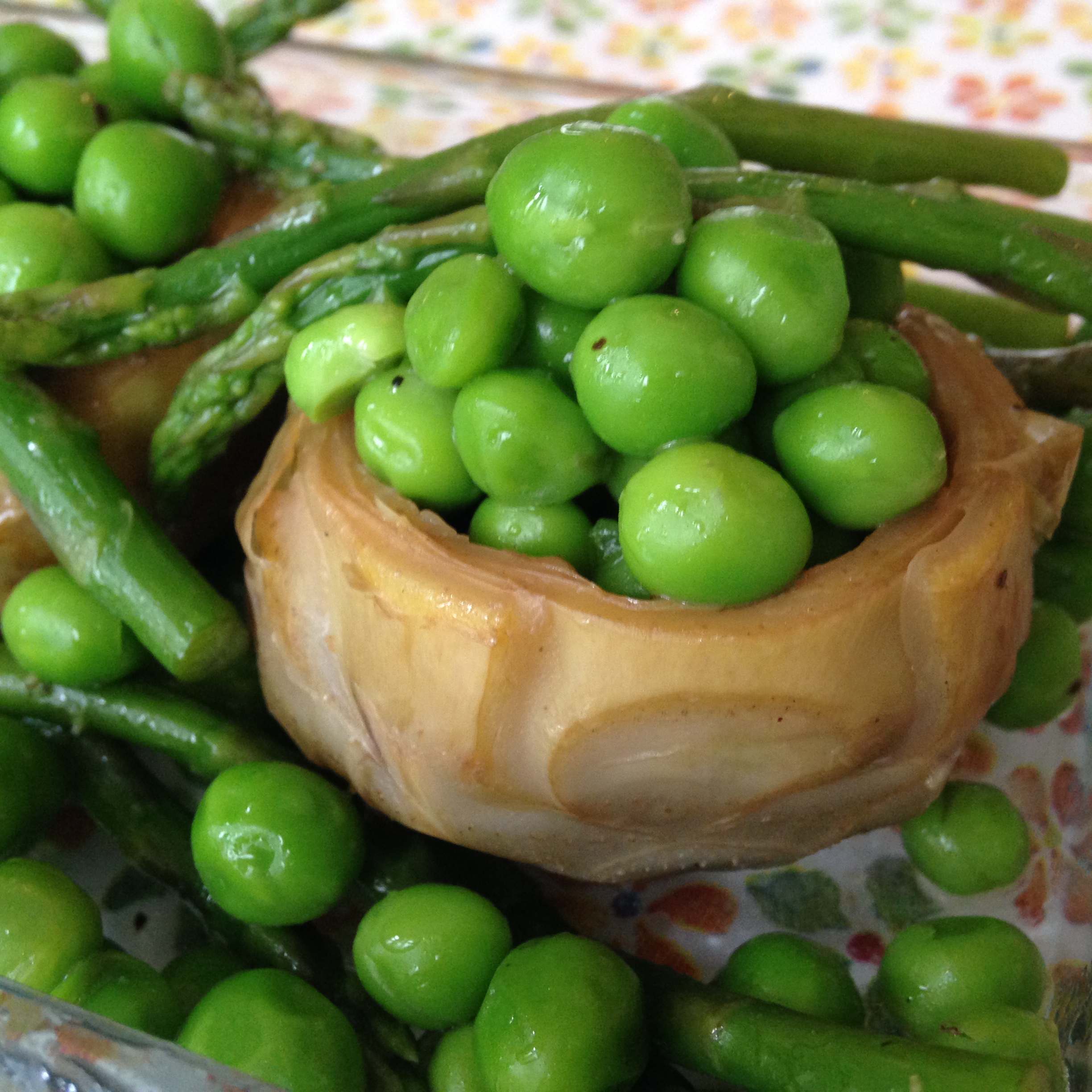
- 4 globe artichokes (the bigger the artichokes the bigger the artichoke cups)
- 1 lemon
- 3 cups of fresh or frozen peas
- 1/4 lb of fresh baby asparagus
- 3 tbsp butter
- salt and pepper
- Cut the lemon in half.
- Fill a medium bowl with water. Squeeze 1/2 the lemon into the water. This water bath will be used to store the artichoke hearts and help prevent them for browning. Use the other half of the lemon to rub the artichoke directly while cutting it to avoid oxidation.
- Using a sharp knife, cut the top 1/3rd of the artichoke off.
- Remove the hard, outer, bottom leaves of the artichoke. The heart will begin to reveal itself.
- Using a pairing knife, carefully cut off the hard bits remaining from the leaves that were just removed cutting from the top down toward the stem. The stem can be peeled, too. Rub the artichoke with lemon where it has just been cut.
- Using the pairing knife, cut the leaves of the artichoke that are above those that were just removed by cutting around the circumference of the artichoke. Cut just deep enough to remove the leaves. More of the heart will reveal itself and the line between the heart and the upper leaves will be seen. Slice the upper leaves off at that line. Rub the artichoke with the lemon.
- After slicing off the upper leaves, the choke will be revealed. It is the hairy purple part in the center. Gently scoop the choke out with a spoon to create the artichoke cup. Rub the inside of the heart with the lemon. Trim the stem off so the bowl can sit on its own. Trim the bowl of any remaining hard parts. Put the heart in the bowl of lemon water. Reserve the stem for other cooking use.
- Repeat the above steps until all the artichoke hearts are removed and turned into bowls remembering to rub them with lemon as you go and storing them in the lemon water until ready to cook.
- Fill a medium pot with water and bring the water to boil.
- While the water is coming to boil, create an ice bath by filling a large bowl with ice and water.
- When the water boils add the asparagus. Blanch the baby asparagus for about a minute (this will depend on the size of the asparagus) or until the asparagus is bright green and tender but not mushy.
- Remove the asparagus immediately and plunge it into the water bath to stop cooking.
- When the asparagus are cool, drain them well.
- If frozen peas are used, make sure they are defrosted (no blanching needed).
- If fresh peas are being used, refresh the water in the pan and bring it to a boil. Refresh the ice bath. When the water boils, add the peas. Blanch the peas for about 2 minutes (this will depend on the size of the peas) until they are bright green and just tender.
- Plunge the peas immediately into the ice bath to stop cooking. When they are cool, drain the peas.
- Fill a medium pot with water and salt the water to taste.
- Bring the water to a simmer. Add the artichoke bowls and simmer until they are tender about 10-12 minutes.
- Remove the artichoke bowls to a serving dish. Tent the artichoke bowls with a piece of aluminium foil to keep them warm.
- In a large saute pan, heat 3 tbsp of butter. When the butter is melted, add the peas and asparagus and toss them well until they are heated through. They have already been cooked and need only to be heated. Season with salt and pepper to taste.
- Spoon the peas and asparagus into the artichoke bowls.
- Serve hot.
- If baby asparagus is not available use the tips of regular asparagus.
- Artichoke hearts are delicious, but are a lot of work. To cheat, purchase artichokes hearts at the grocery store. They are found in cans or in the freezer section. They may be available in cup form. If you wish to omit the cup part, simply defrost (if frozen) and dice the artichoke hearts and toss in butter with the peas and asparagus.
- For a vegan option, omit the butter and use olive oil or a vegan, soy margarine.
Easter Side Dishes – Asparagus with Hollandaise
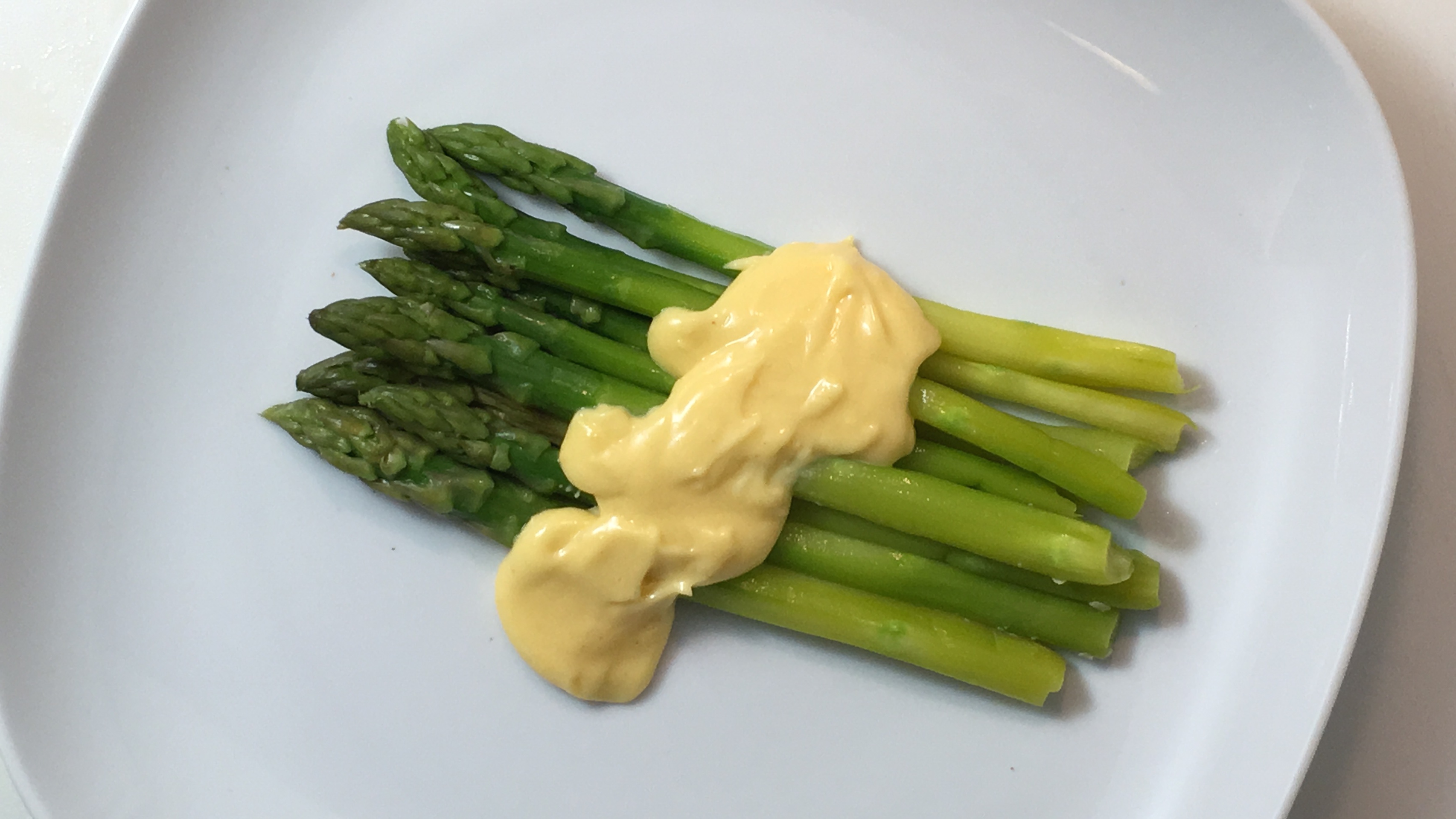
- 1 lb of fresh green or white asparagus
- 2 eggs
- 1 lemon
- 1 tsp of corn starch (optional)
- 1 tbsp of water
- 1 stick of butter
- salt
- cayenne pepper
- Wash the asparagus. Remove the rough ends of the asparagus with a paring knife or by breaking them off.
- (Optional) Using a vegetable peeler, gently remove the outer skin of the asparagus stalk below the tip.
- Separate the eggs reserving the egg whites for another use.
- Cut the lemon in half and, using a reamer, squeeze the juice of the lemon into a bowl.
- In a heatproof bowl that can be the top of a double boiler, whisk together the egg yolks, 1 tbsp of lemon juice, 1 tbsp of water, the corn starch if using, a dash of salt and a dash of cayenne pepper. Whisk until well mixed.
- In a small pot, melt the butter over medium heat. When the butter is melted turn off the heat and allow the solids to settle to the bottom. For convenience and ease of drizzling, transfer the melted butter to a measuring cup or other vessel with a lip for pouring. Keep the butter warm.
- Set up a steamer on the stove and steam the asparagus until just tender about 1-3 minutes depending on the thickness of the stalks. Remove the asparagus from the steamer and set aside tented with foil to keep warm. You can also allow them to cool completely.
- Fill a pot that will hold the bowl containing the egg yolk mixture with about an inch of water. Turn the heat to medium and bring the water to a gentle simmer. Place the bowl with the egg yolk mixture on top of the pot. Whisk the egg yolks constantly until they double in volume, become pale, and form a thick ribbon with drizzled. Remove from the heat.
- Slowly drizzle the melted butter into the cooked egg yolks a little at a time making sure the butter is fully incorporated before adding more. Keep adding butter and whisking until all the butter is incorporated. If the sauce is too thick, slowly drizzle in warm water until it reaches the desired texture. Season to taste with extra lemon, salt and cayenne pepper.
- Spoon the sauce over the asparagus. Serve immediately.
Easter Side Dishes – Brussels Sprouts with Pecorino and Pancetta
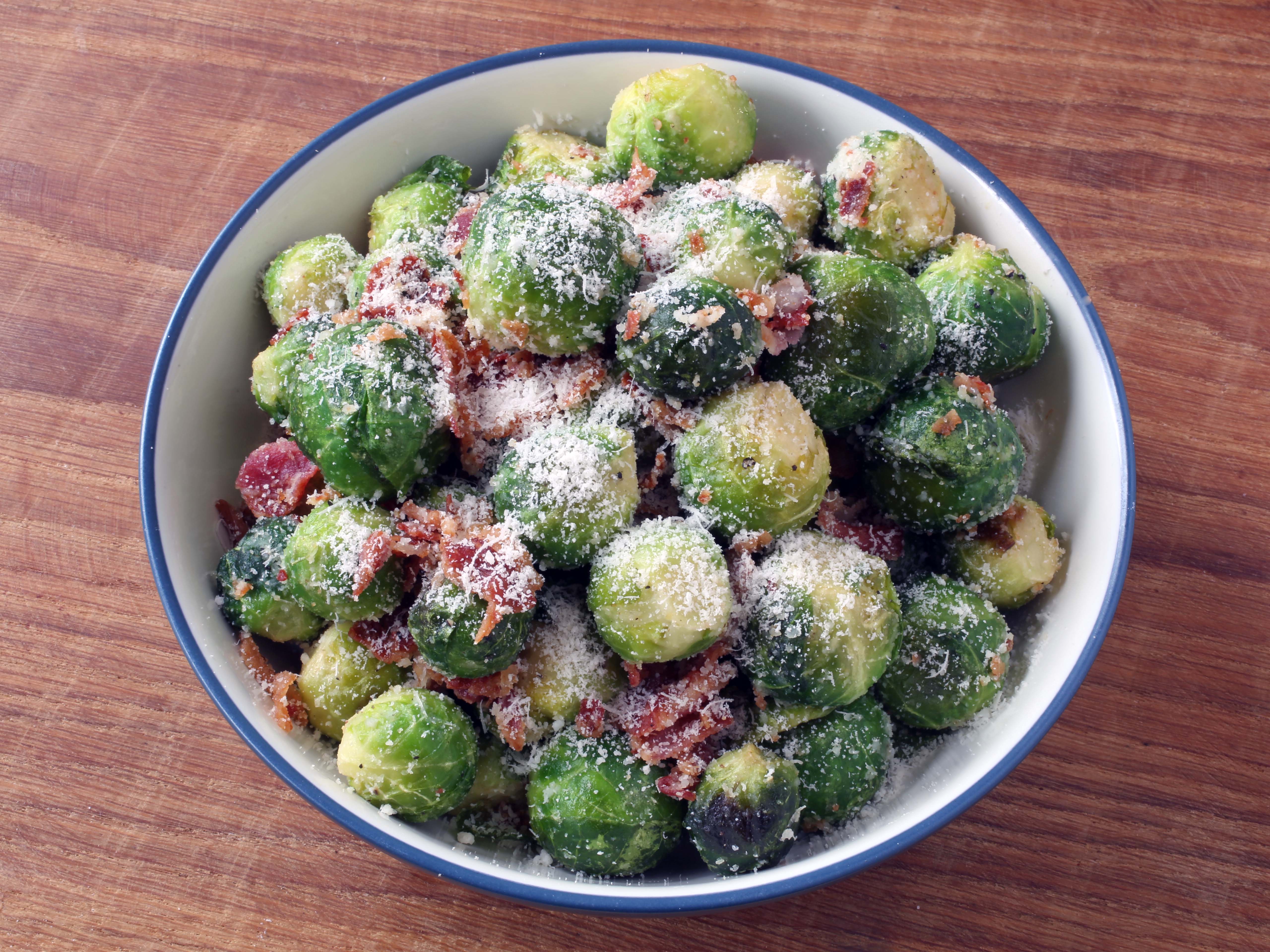
- 2 lb of Brussels Sprouts, cleaned
- 8 rounds/slices of pancetta
- ¼ cup of grated pecorino cheese
- Olive oil
- salt and pepper
- Preheat the oven to 400F.
- Place the sprouts in a large bowl. Toss the sprouts with olive oil to coat.
- Roast the Brussels Sprouts for 20-25 minutes until just tender.
- While the sprouts are roasting, brown the pancetta over medium heat in a non-stick pan until crisp.
- Drain the pancetta on paper towel. With a sharp knife, chop the pancetta into medium pieces. Add the pancetta and cheese to a large bowl.
- When the Brussel sprouts are done roasting, toss them with the cheese and pancetta. Adjust the seasoning with salt and pepper.
- Serve immediately.
- The pecorino can be replaced with parmesan cheese. Pancetta can be replaced with bacon. The pancetta can also be baked.
Easter Side Dishes – Beet and Goat Cheese Tarts
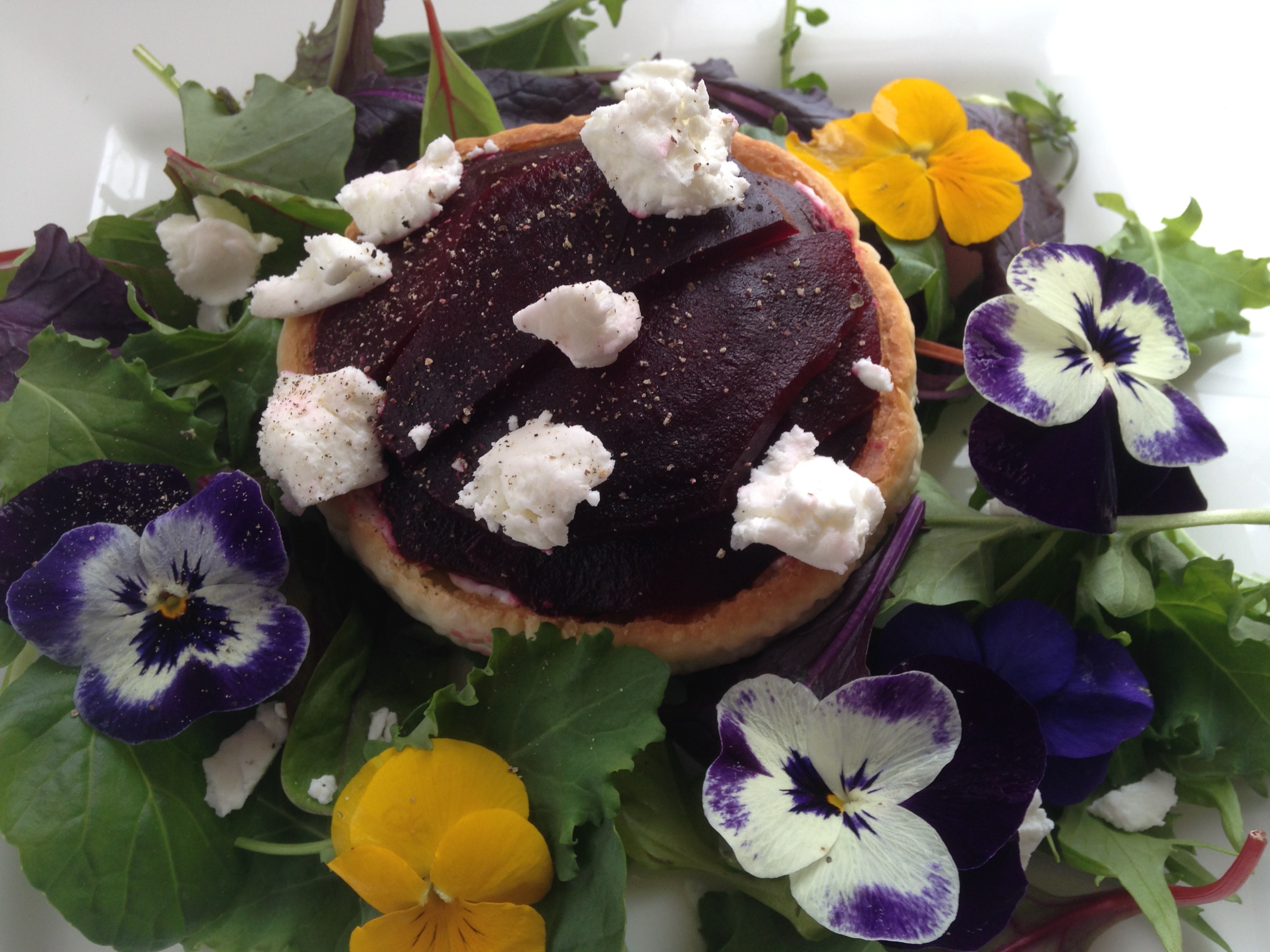
- 3-4 medium beets, any color
- 8 tbsp of olive oil
- 4 tbsp of red wine vinegar
- 2 tbsp of your favorite grainy mustard
- 1 - 10x15 sheet of purchased puff pastry (all butter is best)
- 1/2 pound of your favorite goat cheese
- salt and pepper
- 1/2 lb of peppery greens
- edible flowers for garnish
- Preheat the oven to 425F.
- Clean the beets.
- Wrap the beets in aluminium foil packets and roast in the oven for 45 minutes to an hour or until tender. Let cool.
- Peel the beets with a paring knife.
- Slice the beets in half. Thinly slice the beet halves.
- In a small bowl, whisk together the vinegar and mustard.
- While whisking, slowly drizzle the olive oil into the mustard mixture until the oil is incorporated and emulsified.
- Season with salt and pepper to taste.
- Pre-heat the oven to 400F.
- Unroll the the sheet of puff pastry on to a cutting board. Using a 5 inch round cutter, cut out 4 circles. Place a 4 inch round cutter in the center of each dough circle. Then, using a fork, dock (prick) the dough within the smaller cutter. This will ensure the center of the pastry does not rise.
- Place the circles of pastry on a baking tray lined with parchment paper or one that is sprayed with non-stick baking spray.
- Bake 10-12 minutes until the circles are puffed and just beginning to brown.
- Remove them from the oven. Let cool. If the center of the circles did rise during baking, simply push the centers down gently with your fingers.
- When the crusts are cool, spread a small layer of vinaigrette on the bottom of the crusts.
- Fill the crusts with crumbles of goat cheese.
- Place slices of beets in a fan pattern over the goat cheese. Season with salt and pepper.
- Place the tarts on a baking sheet and return them to the oven. Bake until they are hot and the crust is golden brown about 10 minutes.
- Lay a bed of greens on a plate. Drizzle the greens with vinaigrette.
- Place the tart(s) on the bed of greens. Add a few extra crumbles of goat cheese to the top of the tarts and around the greens.
- Garnish with edible flours.
- The tarts can be served hot or at room temperature. The components of the dish can be made a day ahead and stored sealed in the refrigerator. The tarts should be constructed the day of the meal so the crust bottoms do not become soggy from the vinaigrette.
- For a vegan option, use vegan puff pastry or vegan pie crust. The goat cheese can be replaced with a vegan alternative.
Easter Side Dishes – Tomato Tart
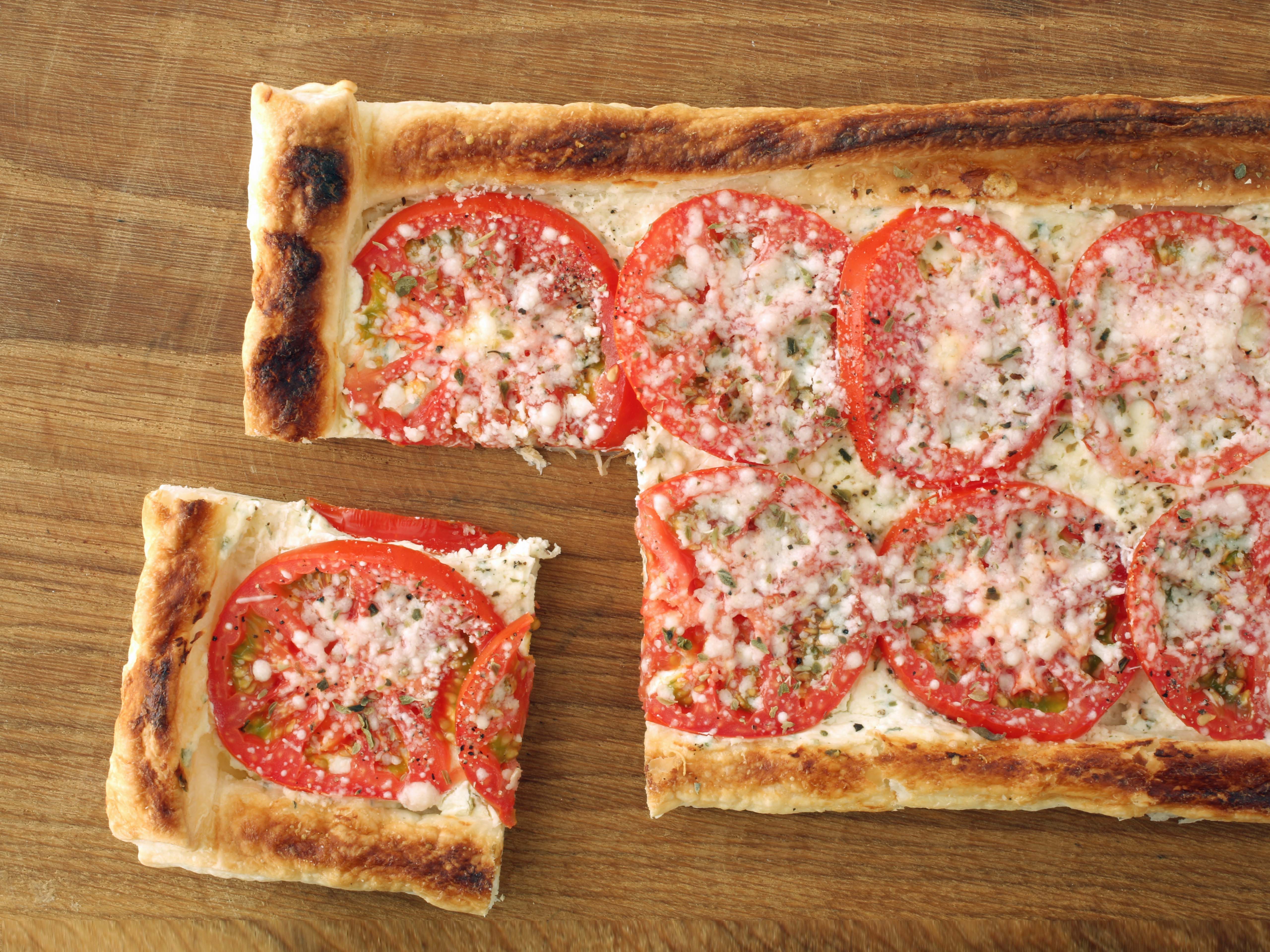
- 1 9x12 sheet of purchased all butter puff pastry
- 1 8oz container of herbed cheese spread like Boursin at room temperature
- 3 tomatoes
- salt and pepper
- 2 tbsp grated parmesan cheese
- Italian seasoning (optional)
- Pre-heat the oven to 400F.
- Place the sheet of puff pastry on a sheet of baking paper.
- Using a pastry cutter, cut 2 one inch strips from the long side of the puff pastry sheet.
- Cut 2 one inch strips from the short side of the puff pastry sheet.
- Brush the edge of the sheet from which the strips were cut with a little water. This will be the bottom of the tart. Place the cut strips around the edges of the bottom sheet using the long strips on the long sides and short strips on the short sides. The strips can overlap and the corners. This will create the edges of the tart. Using a fork, dock the bottom pastry sheet. This will stop the bottom from puffing up.
- Keeping the crust on the baking paper, slide it onto a baking tray and bake for 15-20 minutes until the edges have risen and the crust is just golden brown. Remove the crust from the oven and let cool completely.
- If the bottom puffs up, use a paring knife and slice around the edge of the puffed bottom making sure the knife does not go all the way through crust, then gently press the bottom back down. The edges should be higher than the bottom.
- When the crust is cool, spread the softened cheese all over the bottom of the crust.
- Slice the tomatoes in rounds or half circles and layer them on top of the cheese layer.
- Season with a little salt and pepper.
- Sprinkle the parmesan cheese on top of the tomatoes.
- Sprinkle a dash of Italian seasonings on top.
- Turn on the oven broiler.
- Place the tart under the broiler until the parmesan cheese is just melted and getting bubbly, about 2-3 minutes. Watch to make sure the crust does not burn.
- Slice the tart into squares and serve warm or at room temperature.
Easter Side Dishes – Spring Risotto
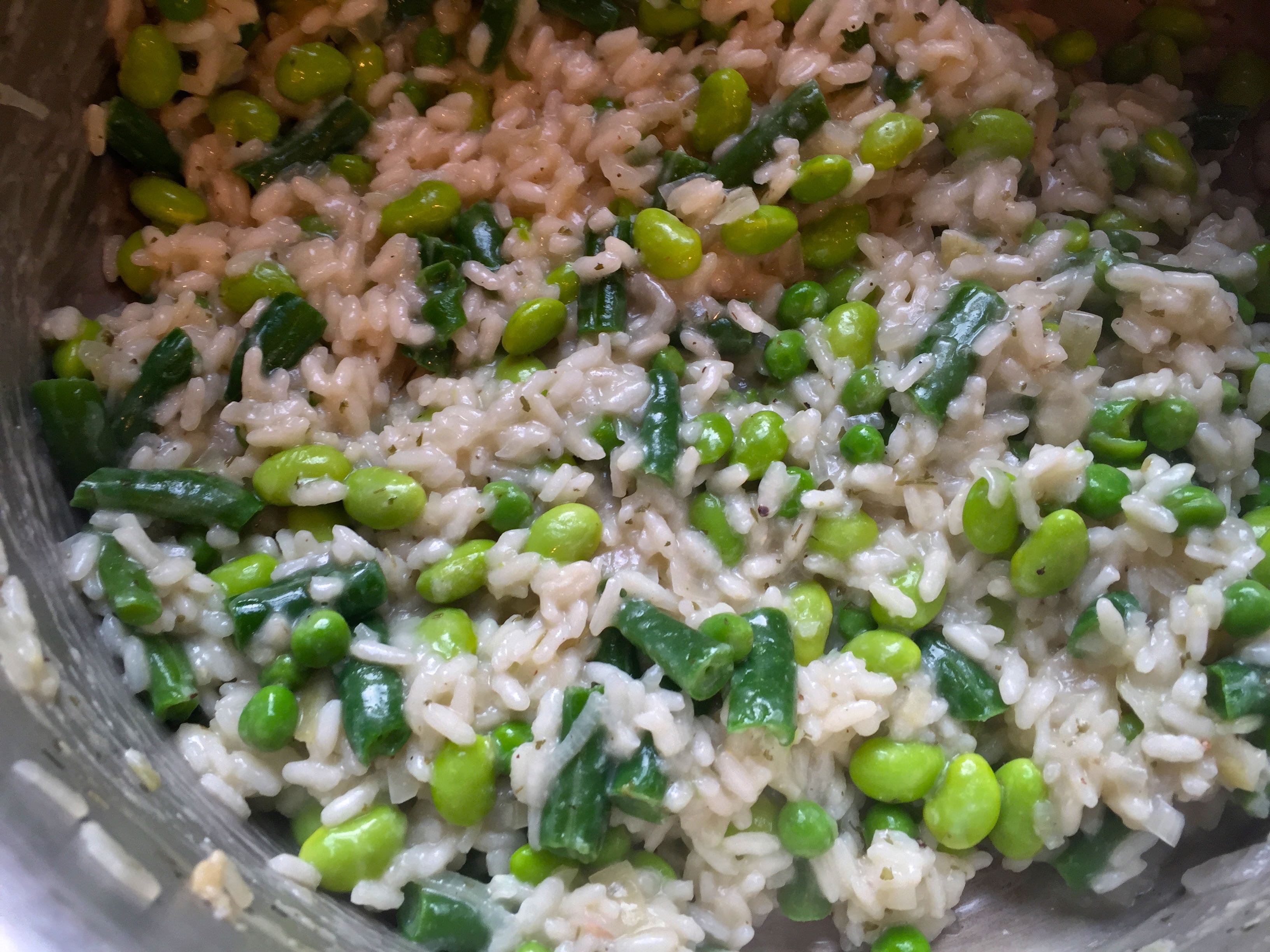
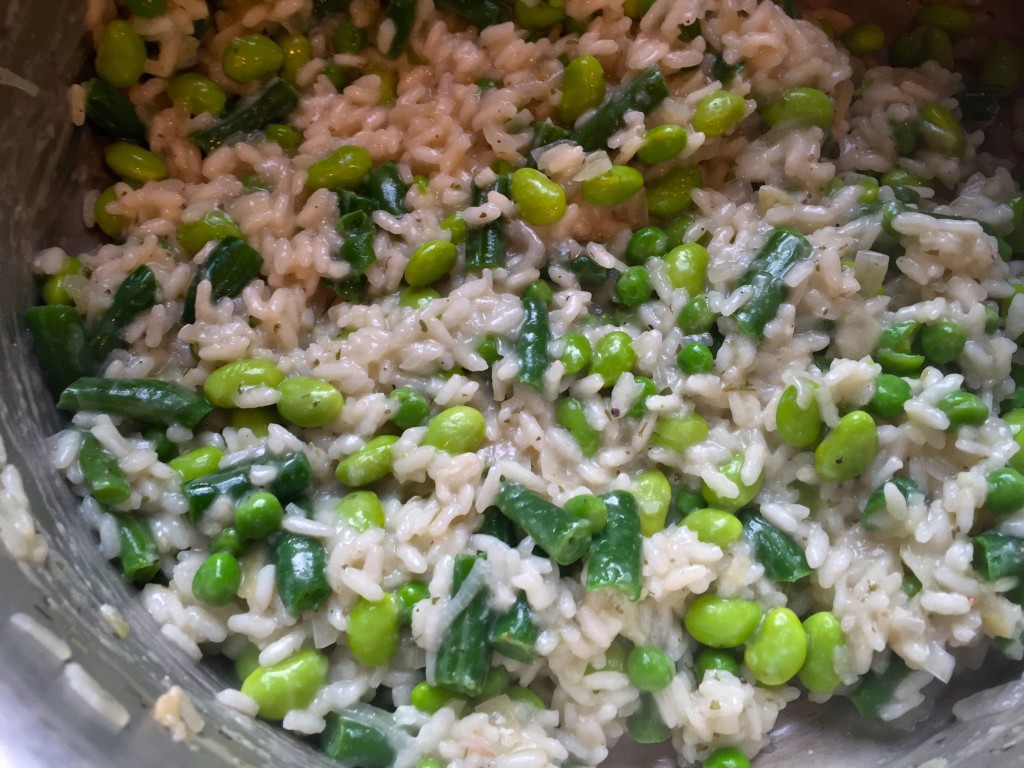
- ¾ cup shallots, chopped (about 2 medium)
- 2 T. unsalted butter or cooking oil of your choice
- 1 cup Arborio rice
- 1 tsp. dried chervil (chives would also work)
- 1 tsp. Penzey’s shallot pepper (optional)
- 4 cups stock or water (approximately)
- 1 cup edamame
- ¾ cup green beans
- ½ cup peas
- 2 T. grated Pecorino Romano cheese
- In a medium sauté pan, melt the butter or oil over medium-high heat and add the shallots.
- Cook for several minutes until the shallots begin to soften.
- Then, add the shallot pepper (or salt and pepper) and/or the dried chervil, along with the rice.
- Stir to coat the rice with the herbs, salt and pepper mix, for about a minute or so. You don’t want to burn the rice.
- Add ½ cup of water or stock and stir constantly until the water is absorbed.
- Continue cooking in this manner, adding ½ cup of stock at a time. Risotto requires your constant attention, so stay with it. If you agitate the pan by shaking it over the heat and stirring vigorously, it helps to release the starches in the rice, which makes it creamy and, incidentally, cook a little faster. It just needs more than a little nudge.
- When the rice has almost softened to al dente and plumped up in size, add the frozen veggies and stir to combine. You’ll likely notice they will release some more water and you may not need more stock. This is a bit of a judgment call; just taste the rice and you’ll know.
- Finally, stir in the Pecorino Romano and serve immediately.
- When risotto is handled in this manner—firmly, with authority but attention to detail—it usually cooks in about half an hour. Adding frozen veggies cuts down on the prep time considerably, so just factor that in, based on what you have on hand.
Easter Side Dishes – Roasted Carrots with Pomegranate
- 4 lbs mixed colored carrots (regular orange will work fine)
- 1 pomegranate
- 1 orange
- 1 bunch of fresh oregano
- olive oil
- salt and pepper
- Preheat the oven to 350F.
- Peel and slice the carrots on the bias – into planks.
- Place the sliced carrots in a large bowl. Drizzle with olive oil. Add a nice pinch of fresh oregano. Season with salt and pepper.
- Roast the carrots in a roasting pan until they are fork tender. Check seasoning.
- Add the seeds of the pomegranate.
- Slice the orange in half and squeeze the juice of half the orange on to the carrots. Mix well.
- Serve hot or at room temperature.





